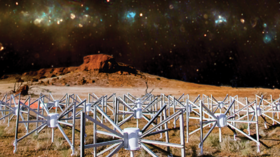Rare ‘missing link’ black hole found – study

Astronomers have discovered a black hole “unlike any other” housed in a star cluster in the nearby Andromeda Galaxy. The “intermediate mass” object is thought to be one of a rare third type of the cosmic phenomena that could be the ‘missing link’ to understanding the evolution of black holes.
The findings, published recently in the Astrophysical Journal, show that the object has a mass 100,000 times greater than the Sun. This makes it smaller than supermassive black holes located at the center of galaxies, but larger than the stellar black holes formed when stars explode.
Using observational data from the Gemini North telescope in Hawaii, the researchers identified the intermediate black hole (IMBH) in a massive star cluster (called B023-G078) that is more than 6 million times the mass of the Sun. The authors argue that the cluster is a “stripped nucleus,” the remnant of a smaller galaxy that fell into a larger one and had its outer stars snatched away by gravitational forces.
Describing these clusters as the “dumping ground for a bunch of different stuff,” study co-author Anil Seth said, “stripped nuclei can have repeated formation episodes, where gas falls into the center of the galaxy and forms stars. And other star clusters can get dragged into the center by the gravitational forces of the galaxy.”
Combining the Gemini North data with images from the Hubble Space Telescope, the team modeled the black hole’s light profile – noticing that the light and chemical make-up of the stars changed as they moved outward from the center. As well, the stars at the center were moving at the highest speeds.
“The stellar velocities... [give] us direct evidence that there’s some kind of dark mass right at the center,” lead author Renuka Pechetti said. “If it’s in a stripped nucleus, then there must already be a black hole present, left as a remnant from the smaller galaxy that fell into the bigger one.”
The researchers are now hoping to examine more stripped nuclei that could hold similar IMBHs, with Seth noting that the finding “fills the gap” between previous detections of supermassive and stellar-mass black holes. “We know big galaxies form generally from the merging of smaller galaxies, but these stripped nuclei allow us to decipher the details of those past interactions,” he said.













